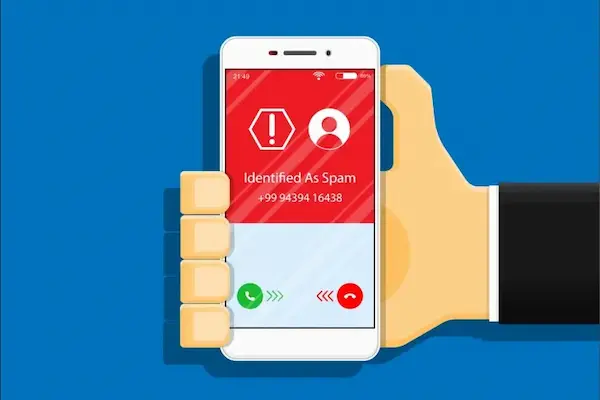Best Apps to Identify and Block Spam Calls
Protect your phone from suspicious calls and messages with this app guide to identify and block spam.
Anúncios
Why you need an app to Block Spam today
Spam and scam calls grow every year.
Scammers automate calls, disguise numbers, and often sound very convincing.
They pretend to be from your bank, a delivery service, a government agency, or even a relative in trouble.
Many people still fall for these schemes and lose money or sensitive data.
Here are some reasons why using apps specifically designed to block spam is almost mandatory today.

1. Built in filters are good, but not always enough
Android and iPhone already bring useful protections.
On Android, Google’s Phone app and Samsung’s Smart Call can identify suspicious calls and silently send many of them to voicemail.
On iPhone, features like “Silence Unknown Callers” and spam identification can also reduce interruptions.
These tools help a lot.
But they depend on your carrier, your region, and limited databases.
Advanced apps go further.
They use huge global databases, artificial intelligence, and community reports to identify new threats much faster.
2. Scammers evolve faster than traditional systems
Fraudsters constantly buy new numbers, use virtual lines, and adapt their scripts.
An app focused on spam blocking usually has:
- A large database of known spam and scam numbers
- Real time updates based on millions of user reports
- AI models that detect suspicious behavior even from new numbers
This gives you a dynamic shield instead of a static list of blocked contacts.
3. Peace of mind and less decision fatigue
Every time your phone rings from an unknown number, you need to decide whether to answer.
This drains attention and creates constant micro stress.
With a good app to block spam, many of those calls never even ring.
Others arrive with clear tags such as “Spam,” “Telemarketing,” or “Possible Fraud.”
You stop wasting energy on every unknown ring and focus only on calls that really matter.
How spam blocking apps work behind the scenes
Understanding how these apps operate helps you choose and configure them with more confidence.
Community and database driven identification
Most top apps combine two main data sources.
- Huge centralized databases with billions of analyzed calls and messages
- Community reports from users marking numbers as spam, fraud, or telemarketing
When a call reaches your phone, the app quickly checks the number against these sources.
If the number is widely reported as spam, the app can block it automatically or show a strong warning.
AI and behavioral analysis
Modern solutions no longer rely only on static lists.
They apply machine learning to recognize patterns like:
- Unusual call volume from a single number in a short period
- Call behavior typical of robocall campaigns
- Known patterns of scam campaigns reported across countries
The result is faster detection of new spam numbers that have not yet accumulated many reports.
Call screening and smart voicemail
Some apps and native tools offer live call screening features.
The call is answered by an automated assistant.
The caller is asked who they are and why they are calling.
You see a live transcript and decide whether to pick up or let it go to voicemail.
On Android, Google’s Call Screen feature does something very similar on Pixel models.
On iPhone, Live Voicemail lets you see what the caller is saying before you decide to answer.
Best apps to Block Spam on Android and iPhone
Now let us look at the main apps you can use to identify and block spam calls and messages.
We will focus on their strengths, limitations, and for whom each one tends to work best.
Truecaller – powerful caller ID plus automatic Block Spam
Truecaller is one of the best known caller ID and spam blocker apps in the world.
It has hundreds of millions of users who help feed its spam database.
Main features
- Caller ID that shows the likely name of unknown callers
- Automatic blocking of calls flagged as spam or fraud
- Community based spam list updated daily
- Blocking of SMS spam in many regions
- Reverse number lookup to identify who called or texted you
Recent updates also added stronger modes like “Max Protection” and “Auto Block Spam,” which block any call flagged as spam or fraud even before your phone rings.
Pros
- Very strong global database thanks to its huge community
- Works on both Android and iOS
- Good balance between identification and automatic blocking
Possible downsides
- Free version has ads and fewer advanced controls
- Some users may feel uncomfortable sharing contacts or call data, so it is important to review the privacy settings carefully
Hiya – clean interface and strong carrier partnerships
Hiya is another big name in the world of spam protection.
It offers its own app and also powers spam detection for several carriers and phone manufacturers.
Main features
- Caller ID with spam and scam detection
- Real time alerts when a number seems risky
- Community reporting to help update the spam database
- Integration with some native dialers and carrier services
Pros
- Simple and lightweight interface
- Strong partnerships with operators and device makers
- Good accuracy in detecting known spam campaigns
Possible downsides
- Some users report that very aggressive filters may block legitimate calls, such as delivery services or support lines, especially when auto blocking is set to the strictest level.
- Premium features require a subscription
Robokiller – advanced AI plus “revenge” on robocalls
Robokiller is focused specifically on stopping robocalls and spam texts.
It uses AI and audio fingerprinting to recognize scam calls before you even hear them.
The company states that it can block up to 99 percent of spam calls and messages based on its large global database.
Main features
- Automatic blocking of robocalls and many spam texts
- AI powered audio fingerprinting to recognize call patterns
- Option to use the app as your default SMS app on Android to block spam messages
- “Answer bots” that pick up spam calls and waste scammers’ time instead of yours
Pros
- Very strong for people who receive a high volume of robocalls
- Focus on both calls and text messages
- Extras like answer bots add a bit of fun to dealing with scammers
Possible downsides
- Works best in regions where the service has strong data coverage
- Subscription cost may be higher than simpler apps
- Some users prefer less aggressive or less “playful” approaches
Call Control – solid option to Block Spam calls
Call Control appears frequently in independent comparisons of call blockers as a good balance between simplicity and effectiveness.
Main features
- Blocking of spam, telemarketing, and robocalls
- Community based spam lists
- Personal block lists for annoying numbers that only bother you
Pros
- Recommended by some tests for users who “just need to block spam calls”
- Focused feature set without too many distractions
Possible downsides
- Interface and availability of features can vary between Android and iOS
- Database may not be as large as that of Truecaller or Robokiller in some regions
Should I Answer – community powered call reputation
“Should I Answer” is another community driven app that focuses on rating numbers.
Instead of just saying “spam,” it gives reputation scores and context based on user feedback.
Main features
- Reputation scores for numbers based on community reviews
- Blocking of numbers with poor ratings
- Offline database to protect you even without active internet in some cases
Pros
- Very transparent about why a number is considered risky
- Good for people who want to see more context before blocking
Possible downsides
- Interface is less polished than some competitors
- Depends heavily on active community in your country
Carrier apps – extra layer to Block Spam at the network level
Many carriers now offer their own apps or services to block spam calls and texts.
Some examples include solutions like AT and T ActiveArmor, Verizon Call Filter, and T Mobile ScamShield in the United States.
Main features
- Identification and blocking at the network level before the call fully reaches your phone
- Additional alerts and caller identification based on carrier data
Pros
- Often free or included in certain plans
- Can work together with apps like Truecaller or Hiya for extra protection
Possible downsides
- Availability and quality vary a lot by country and carrier
- Features may be more basic than those of dedicated apps
Built in tools to Block Spam without extra apps
Even if you use a dedicated app, it is worth activating your phone’s own protections.
Android – Google Phone, Samsung Smart Call, and more
On many Android phones, Google’s Phone app offers caller ID and spam protection.
You can turn on a setting that warns you when a call is suspected to be spam and even automatically send those calls straight to voicemail.
Samsung devices include Smart Call, which also uses spam databases in partnership with services like Hiya to identify and block suspicious calls.
These native options may be enough for some users.
But if you still receive many spam calls, combining them with a specialized app can greatly strengthen your shield.
iPhone – Silence Unknown Callers and Live Voicemail
On iPhone, you can enable “Silence Unknown Callers” in the Phone settings.
With this activated, calls from numbers not in your contacts, not in Siri suggestions, and not from recent outgoing calls go straight to voicemail.
You still see them in your recent calls list, and they can leave a voicemail.
But your phone does not ring.
Newer versions of iOS also include Live Voicemail, which transcribes messages in real time so you can decide whether to pick up.
This combination can drastically reduce interruptions.
However, it may also silence some important but unknown calls, such as a new doctor’s office or delivery company.
That is why many people combine these native tools with a smarter app that can differentiate between likely spam and legitimate calls.
How to choose the best app to Block Spam for your routine
There is no single app that is perfect for everyone.
The ideal tool depends on your region, your phone, and the volume and type of calls you receive.
Here are key points to consider.
1. Operating system and phone model
First, check if the app is available and well supported on your device.
Some apps have more complete features on Android than on iOS, or vice versa.
Pixel and Samsung users, for example, already have strong native tools and might use an additional app mainly for better caller ID and global spam protection.
2. Balance between aggressiveness and safety
More aggressive blocking means fewer spam calls.
But it also increases the risk of blocking important calls, such as deliveries, support services, or unknown numbers that you actually need to answer.
Look for apps that let you fine tune the level of protection.
For example, you can usually choose between:
- Only warn about suspicious calls
- Automatically block high risk spam
- Block all unknown numbers and allow only your contacts
Start with intermediate settings and adjust based on your experience.
3. Quality of the spam database in your country
The effectiveness of any app depends heavily on local data.
An app that works wonderfully in one country may be less accurate in another.
Look at user reviews in your app store from people in your region.
Check whether they mention good detection of local telemarketers and scam campaigns.
4. Privacy and data usage
To identify and block spam, some apps request access to your contacts and call logs.
Read the privacy policy calmly.
Choose tools from companies that explain clearly how data is processed and anonymized.
If you are uncomfortable sharing some data, prefer apps that offer more limited modes or that focus on local blocking lists.
5. Price and value
Many apps have a free version with basic blocking and a paid plan with extra features.
Ask yourself what you really need.
- If you just want to cut down on obvious spam calls, a free app plus native features may be enough
- If you suffer from constant robocalls and spam texts, a premium tool like Robokiller or a well maintained community app may be worth the subscription
Step by step – setting up your Block Spam shield
Here is a simple roadmap you can follow today.
You can adapt it to any app you choose.
1. Turn on your phone’s built in protections
- Open your Phone or Call settings.
- On Android, enable caller ID and spam protection features.
- On iPhone, consider turning on “Silence Unknown Callers” and review spam call options.
- Test for a few days and see how many spam calls still get through.
2. Install one main app to identify and block spam
Avoid using many blocking apps at the same time.
They can conflict with each other.
Choose one main app like Truecaller, Hiya, Robokiller, Call Control, or Should I Answer based on your profile.
Download it from the official App Store or Google Play.
3. Configure permissions and protection level
When you open the app for the first time, it will ask for permissions.
Authorize only what is necessary for spam detection and blocking.
Then choose your desired protection mode, such as:
- Only identify spam
- Block known spam and high risk scams
- Block all unknown numbers except your contacts
Start with “identify plus block high risk spam” if available.
This usually offers a good balance at the beginning.
4. Create your own allow list and block list
Most apps let you mark numbers as “always allow” or “always block.”
Add your bank, doctor, delivery services, and other important contacts to your allow list.
This reduces the risk of losing important calls even with strong filters.
Also, whenever a number bothers only you, mark it as blocked.
This personal block list is a powerful complement to the global database.
5. Review blocked and recent calls regularly
Once a week, open your app’s “Blocked calls” or “Recent activity” section.
Check if any legitimate call has been blocked by mistake.
If you find one, mark it as allowed so that it never gets blocked again.
This small habit keeps your Block Spam shield smart and safe.
Extra tips to stay safe beyond apps
Apps and phone settings are essential.
But your behavior is also a crucial line of defense.
- Never share sensitive data like passwords, full card numbers, or one time codes by phone with unknown callers
- If someone claims to be from your bank or government, hang up and call the official number printed on your card or official website
- Be suspicious of calls that pressure you to act fast, pay immediately, or share codes
- Agree on a “safe word” with family members to avoid scams where someone pretends to be a relative in trouble
- Prefer official apps and websites for financial and government services whenever possible
Frequently asked questions about apps to Block Spam
Are these apps 100 percent effective
No solution can block every single spam call.
But a good combination of phone settings, carrier tools, and a specialized app can drastically reduce the problem.
The goal is to block most spam before your phone rings and clearly label the rest so that you rarely waste time answering.
Can apps to Block Spam also filter messages
Yes.
Several apps, such as Truecaller and Robokiller, also help detect and block suspicious SMS or messaging spam in supported regions.
Always check the description in your app store and adjust message permissions if you want this extra protection.
Will I miss important calls if I use very strong blocking
It is possible, especially with very aggressive filters that block many unknown numbers automatically.
To reduce this risk, start with intermediate settings and build a good allow list of important contacts and organizations.
Review blocked calls regularly and fine tune the protection level based on your experience.
Do you have any link or partnership with these apps
No.
This article is purely informational.
We do not own, operate, control, or have any affiliation or sponsorship from Truecaller, Hiya, Robokiller, Call Control, Should I Answer, phone manufacturers, carriers, or any other platform or institution mentioned here.
Important disclaimer
You are responsible for reviewing terms of use, privacy policies, and costs of each app or service before installing or subscribing.
Always follow local laws and your carrier’s rules when using call blocking and recording features.


